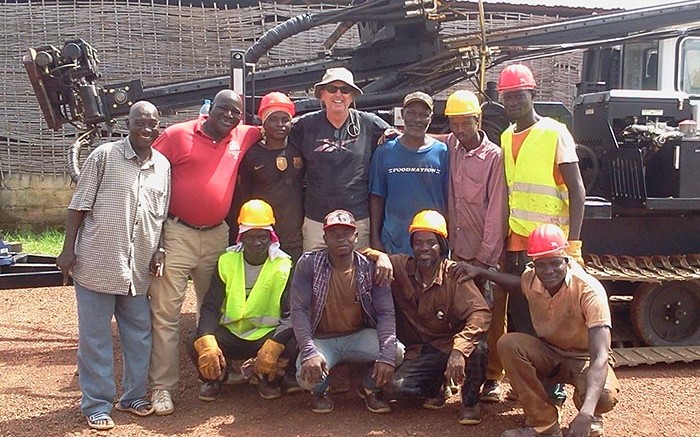Free-digging saprolite and favourable metallurgy at African Gold Group’s (TSXV: AGG; US-OTC: AGGFF) Kobada open-pit gold project in Mali will help keep a lid on costs, according to an updated preliminary economic assessment, which estimates life-of-mine cash costs of US$694 per oz.
Cash costs in the first two years of Kobada’s 15-year mine life come in even lower, at US$482 per oz., while all-in sustaining costs over the mine’s life are closer to US$792 per oz.
The study — based on a recently updated resource estimate — states that the project can be built for US$46.6 million, which includes a US$6.1-million contingency, and that the capital can be recovered in 18 months.
Annual production in the first two years of operation would average more than 50,000 oz. gold, with life-of-mine average annual production of 44,000 oz. gold.
The company didn’t have post-tax numbers available by press time, but says that at a US$1,000 per oz. gold price the pre-tax net present value — using a 5% discount rate — works out to US$66 million, and the pre-tax internal rate of return, 30%. Those numbers rise to US$172 million and 62%, using a US$1,250 per oz. gold price.
In terms of the mining operation, the saprolite rocks are weathered and free digging, which means the company won’t need to drill or blast, and that will translate into average mining costs of US$2.56 per tonne of waste and US$3.85 per tonne of ore mined.
In a telephone interview from his home in Brisbane, Australia, president and CEO Declan Franzmann says the process flow sheet can be described in three steps: pre-concentration, gravity concentration and leaching of concentrates. From a cost perspective the most important is the pre-concentration. This part of the process involves conventional “hydro-cyclones,” and splitting material based on particle size. It is a characteristic of the heavily weathered Kobada deposit that more than half of the feed material can be rejected at a size of -0.15mm (-150 micron), without any grinding, and only losing 4% of contained gold, he explains.
The second step is gravity concentration, which is a classification of material based on mass or weight. The relatively coarse, free-milling nature of the gold mineralization at Kobada means that this process is efficient, he says. This classification rejects 98% of the material (after pre-concentration), but leaves 86% of the gold in the 2% concentrate. Again, it is a characteristic of the Kobada deposit that makes this possible without grinding.
In the final leaching step, the concentrate is ground to a fine slurry to increase gold recovery in the leaching process.
“It is the mass reduction in the pre-concentration and gravity steps that are so cost effective,” Franzmann says. “These techniques are not energy intensive and there are no chemical additives. Pre-concentration and gravity concentration for the Kobada deposit are effective and inexpensive processes.”
Initial mining will be from two starter pits before stripping to the final pit limits starts in year four. The final pit would run to 100 metres deep with a 3.5 km strike length and a 400-metre maximum width.
Franzmann says construction could take as little as half a year and notes that, depending on financing, the operation could enter production as early as 2016.
Kobada has measured and indicated resources of 36 million tonnes grading 1.05 grams gold per tonne for 1.2 million contained oz. gold, and inferred resources of 39 million tonnes averaging 1 gram gold per tonne for 1.21 million contained oz. gold.
The project is 125 km southwest of Bamako, Mali’s capital, and close to the West African nation’s border with Guinea. Randgold Resources’ (NASDAQ: GOLD; LSE: RRS) Morila mine is 170 km east; Resolute Mining’s (US-OTC: RMGGF; ASX: RSG; ) Syama project, 280 km east; and Hummingbird Resources’ (LSE: HUM; US-OTC: HUMRF) Yanfolila property, 36 km south.
African Gold acquired the property in 2005 from a subsidiary of the Geological Survey of France. The earliest recorded exploration dates to the 1930s.
Franzmann says there are artisanal workings all over the concession and that the company has another 8 km of strike on the shear system that has not been explored.
“There is a lot of exploration work we can do to identify near-surface resources that we could quickly turn into a production story along with what we’ve got in the preliminary economic assessment, and those opportunities really add to the project,” he says.
African Gold says it has already identified potential satellite deposits at Foroko North, 1.5 km north of Kobada; the Termite zone 1.5 km southeast that contains a similar geochemical and geophysical signature; and the Gosso target, 5 km east of Kobada.
At Foroko North, drilling by African Gold between 2010 and 2012 returned assays including 23 metres grading 2.10 grams gold from 80 metres downhole; 91 metres averaging 1.42 grams gold from 15 metres; 62 metres of 1.04 grams gold from 45 metres; and 48 metres of 1.28 grams gold from 55 metres.
Management holds 10% of the company. Other shareholders are Sprott Asset Management, RBC Global Asset Management, Sentry Select, PAM Asset Management, Dundee Resources and Insight Capital.


Be the first to comment on "African Gold Group touts low costs for Kobada in Mali"